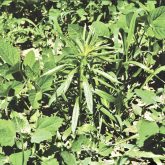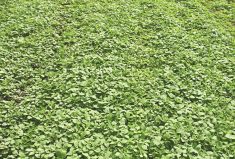In farming circles, 2017 may be remembered for a profound addition to our technology with the launch of the Roundup Ready 2 Xtend soybean system and its companion herbicides, XtendiMax with VaporGrip technology and Engenia.
Long anticipated, the Roundup Ready 2 Xtend Crop System brings with it the potential to solve many issues with glyphosate-resistant weeds as well as to enhance weed control overall.
But there is a challenge too, due to the potential for the dicamba in the Xtend herbicides to injure nearby sensitive crops.
Below, we ask Joe Vink, weed management technical lead with Monsanto Canada, and Rob Miller, technical development manager for Eastern Canada with BASF, about the roll out of the new technology, and importance of training and education to its success.
Read Also

Agronomists share tips for evaluating new crop products and tech: Pt. 3
With new products, new production practices and new technology converging on the agriculture industry at a frenetic pace in recent…
- Read more: The Xtend balancing act
Q: What’s the greatest challenge with the Xtend technology at this point?
Rob Miller — It’s a learning process, and there are two approaches that we’re taking. First is the weed management strategy, incorporating multiple modes of effective action, and second is the education side. This is great technology, it’s new, it’s exciting, and we want to make sure it’s around for several years. We don’t want to burn out dicamba the way we did with glyphosate.
We know that dicamba isn’t a silver bullet. It does have some weaknesses, so we need to incorporate other modes of action and even consider things such as tillage, cover crops, herbicides and crop rotations. But there’s also the second component which would be the off-target education. That would include the proper nozzles, the boom height, the wind speed, educating users on temperature (thermal) inversions and also explaining the difference between volatility and drift.
Joe Vink — First and foremost, for some growers, it’s getting out of that “Roundup Only” mindset.
There needs to be greater understanding that if I’m applying Roundup plus XtendiMax beside a sensitive soybean field, for example, which isn’t Xtend technology, I have to be careful. You’re not just spraying Roundup. You’re spraying Roundup plus XtendiMax.
Then there’s the question of understanding drift and volatility, and temperature (or thermal) inversion. Inversions occur more often than we think, before sunrise and at sunset, and the off-target injury observed could look very similar to volatility.
Both of the new formulations are extremely low volatility compared to their older counterparts. We need to focus on minimizing drift through proper nozzle selection and making applications in the right conditions, and we also need to focus on triple-rinsing systems, and on temperature inversions and when not to spray in them.
Q: What do growers and the crop protection sector need to watch?
Joe Vink — Part of the process is understanding how little dicamba it takes. With Roundup, you can get away with it; the symptoms are more subtle and the dose is not often high enough to elicit a response with Roundup alone. With dicamba, you can’t get away with that. It takes such a small amount to cause a crop response on a sensitive, adjacent species.
Applicators need to read the label. Monsanto and BASF are aligned on these recommendations, and you don’t see that that often in the industry because we’re competing companies. But stewardship is something we are aligned on, and that’s a positive.
Rob Miller — One of the misconceptions is that you don’t see that crop response for two to three weeks after, so a lot of people might think it “got up and moved,” while it could have happened as a drift event at the time of application, but the symptoms didn’t show up until two or three weeks later.
That’s why the manufacturers have come out with newer formulations, and only these newer formulations should be used moving forward on Xtend soybeans. But it’s also the education component: when to spray, when not to spray, what are temperature inversions. That’s part of the education process as well.
Q: How stringent will the guidelines have to be?
Rob Miller — If you look at our herbicide label, we have very strict guidelines that reflect our stewardship philosophy. Every one of our technical sheets has information on nozzles, boom height, wind speeds, tank contamination, and different additives that you may or may not be able to include. Whenever we talk about dicamba, we always talk about weed control and stewardship. That’s on our label, and we’re informing people that it’s on our label. We’re also educating them on taking detailed notes. What was the time of day, what was the temperature, what were you spraying, what was the height of the crop, what stage was it at? Then they have a record of that application.
Joe Vink — It’s all about training and education, at all levels. And as part of that training and education, it’s helping growers understand that the application requirements are part of the label. It’s a legally binding document, and the application requirements are not written as “if you can,” they’re written as “this is required.” It’s expected that applicators and growers read and follow the label.
That’s for every pesticide label that growers use, not just dicamba.
Q: Do the events in the southern U.S. in 2016 provide a learning opportunity?
Joe Vink — It highlighted the worst-case scenario — using off-label formulations, spraying late, spraying in the middle of the night during temperature inversions, adding ammonium sulphate — those are not good situations. But for us, it’s an opportunity to learn from those mistakes, highlight those worst-case scenarios and build on those education efforts.
In terms of farmer-grower terminology, we’re saying four things:
- Apply it at the high rate on the first pass, and capitalize on early weed removal. Since you’re applying it early, you minimize your chance of something moving next door.
- Get the proper nozzles now. Find those Turbo TeeJet Induction nozzles and make sure those are in place.
- When a glyphosate-resistant weed is on that acre, you have to include a second effective mode of action. If it’s glyphosate resistant, and you’re just using dicamba, then dicamba is the only effective mode of action on that weed, and we’ve learned from history that that’s a bad path to take.
- Just because the beans are resistant to dicamba, you should not be thinking that you have to spray dicamba every time you spray a field.
Rob Miller —We’ve been promoting the technology with summer tours, our retailer training events, our grower meetings — even educating our own field staff. We’ve been showing them what can happen and the differences between volatility and drift, and when is it safer to apply.
We’ve also taken the standpoint that the Xtend soybean system is a great tool, when managed effectively, and that growers need to incorporate multiple modes of action. Use tank mixes with alternative chemistry pre-plant or up front, and if you need to come back in, you might even just have to come back in with straight glyphosate post-emerge, depending on your weed spectrum.















